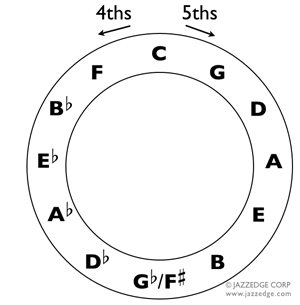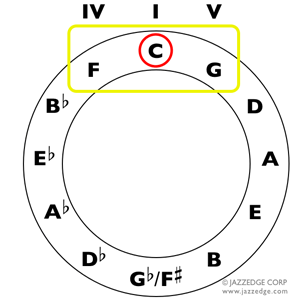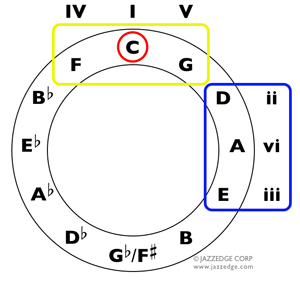Using The Circle of Fifths

The Circle of Fifths
The circle of fifths is a fantastic practice tool. It can help you practice scales more effectively, learn key signatures and even learn basic and advanced harmonization techniques.
In this article, I am going to show you some circle of fifths "tricks" that will help you maximize your practice.
What is the Circle of Fifths?
The circle of fifths is all 12 keys of music written on a wheel or "circle". The keys are divided into intervals of a fifth. Looking at the circle of fifths below, you'll notice that at the top is 'C' and moving clockwise, we move through all twelve keys by intervals of a fifth. So we start with C, then go to G, D, A, E, B, F# (or Gb...same note), Db, Ab, Eb, Bb, F and end back at C.
If you go counter-clockwise (to the left) we move through all twelve keys by fourths. Starting with C, we move a fourth to F, Bb, Eb and so on.
How to incorporate the Circle of Fifths into your practice routine
Perhaps the easiest way to use the circle of fifths is to use it as a scale practice tool. Let me explain...
When practicing scales (Major, minor, etc...) I often see students get very good at playing their scales in easy keys like the key of C, F or G. However, when it comes to more challenging keys like Gb, Ab, etc., students become a bit "shy". This is usually because they have practiced a lot in the easy keys but not as much in the difficult keys.
Many times, this imbalance of scale practice is because students sit down, practice three or four scales then move on to something else. The next day, they sit down, start with the same scales and never end up practicing those more difficult keys.
You can break this pattern by using the circle of fifths. Download and print the circle, then while practicing, mark which of the keys you practiced. For example, circle the keys you practice on day 1, put a triangle around those you practice on day 2, a box around the scales practiced on day 3 and so on.
Using this method, you can be sure that you get through all keys both easy and difficult.
Learning harmony using the Circle of Fifths
Using the circle of fifths, it is easy to learn diatonic harmony. Looking at the example below, you'll notice a yellow rectangle around F-C-G and a red circle around the C.
The red circle is marking the key. In this example, the key is C Major. The yellow rectangle shows us the IV and V chords. In this example, C is the I chord, F is the IV chord and G is the V chord.
If you move the red circle and yellow rectangle to the right and place it over G, C would become the IV chord and D the V chord.
So, to find the I, IV and V chords, simply follow these steps:
- Pick any key on the circle
- The letter to the left is the IV chord
- The letter to the right is the V chord
Let's take a quick quiz:
- What is the IV chord in the key of A?
- What is the V chord in the key of Bb?
- What is the IV chord in the key of B?
Using the circle of fifths, it is easy to find the answers. Remember, the IV chord is to the left and the V chord is to the right.
To figure out the answer to question 1, put your finger on A, and look to the left. You'll see the answer is D. The IV chord in the key of A is D. Can you quickly find the V chord in the same key?
That's right, just look to the right of A and you'll find the V chord...E.
Diatonic harmony and the Circle of Fifths
We can extend beyond simple I, IV and V chords by adding another rectangle at a 90o angle to our yellow rectangle. See the example below:
In the example above, you'll notice the new blue rectangle. In this example, you'll also notice the ii, vi and iii chords.
So, in the key of C, the IV chord is on the left (F), then going clockwise (in order) we have the V, ii, vi and iii chords which are G, D, A and E.
Remember this phrase: "4 to the left, then 5, 2, 6, 3". Commit this phrase to memory. Got it?
OK, quiz time:
- What is the ii chord in the key of Eb
- What is the vi chord in the key of F
- What is the iii chord in the key of Db
Once again, we can use the circle to easily answer these questions. The answers are: 1) F, 2) D and 3) F


